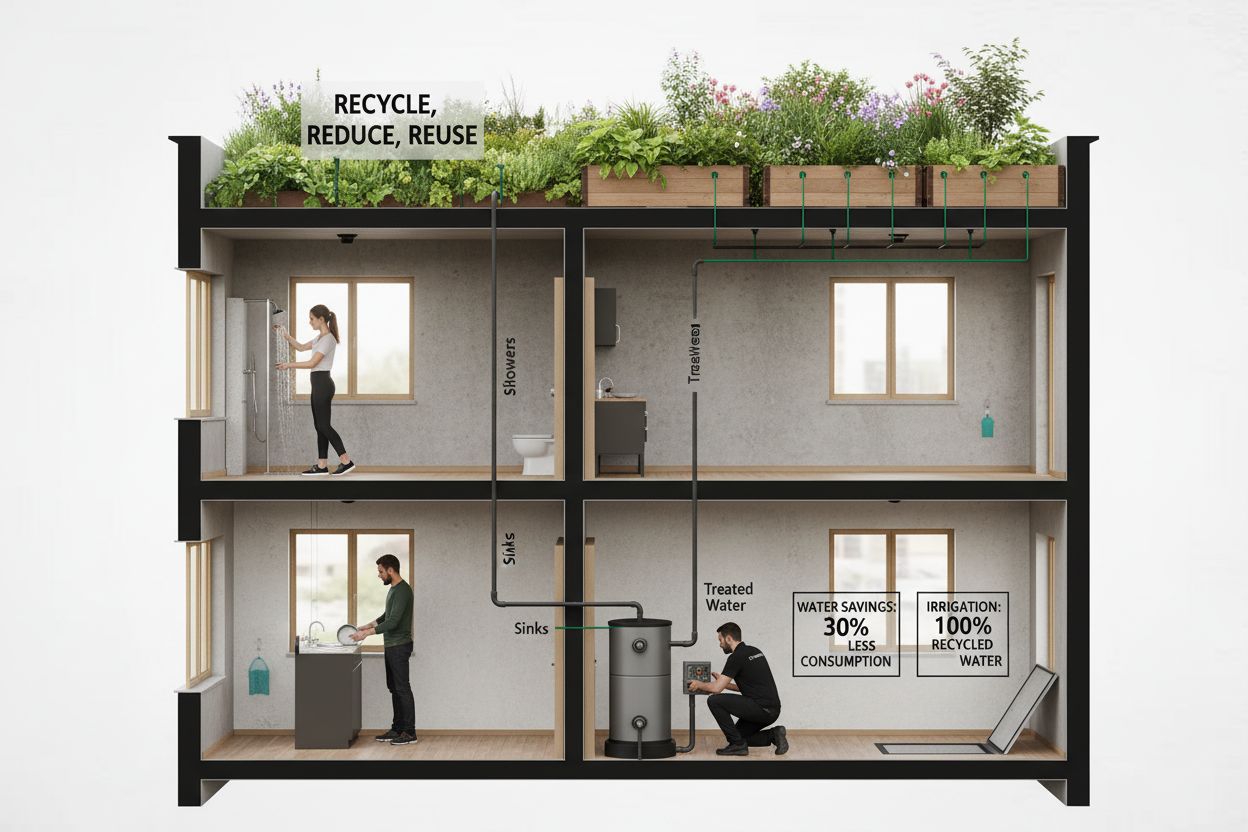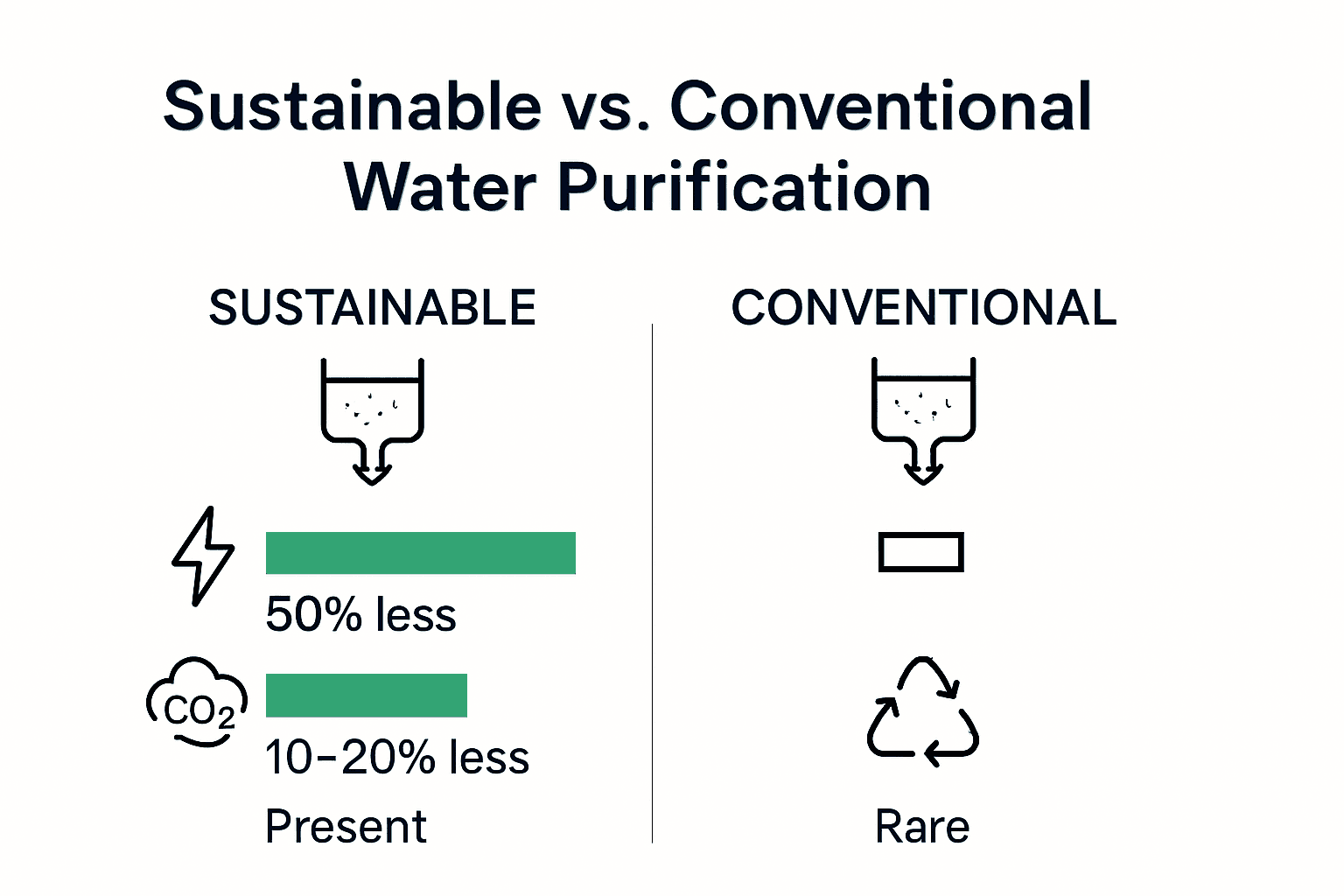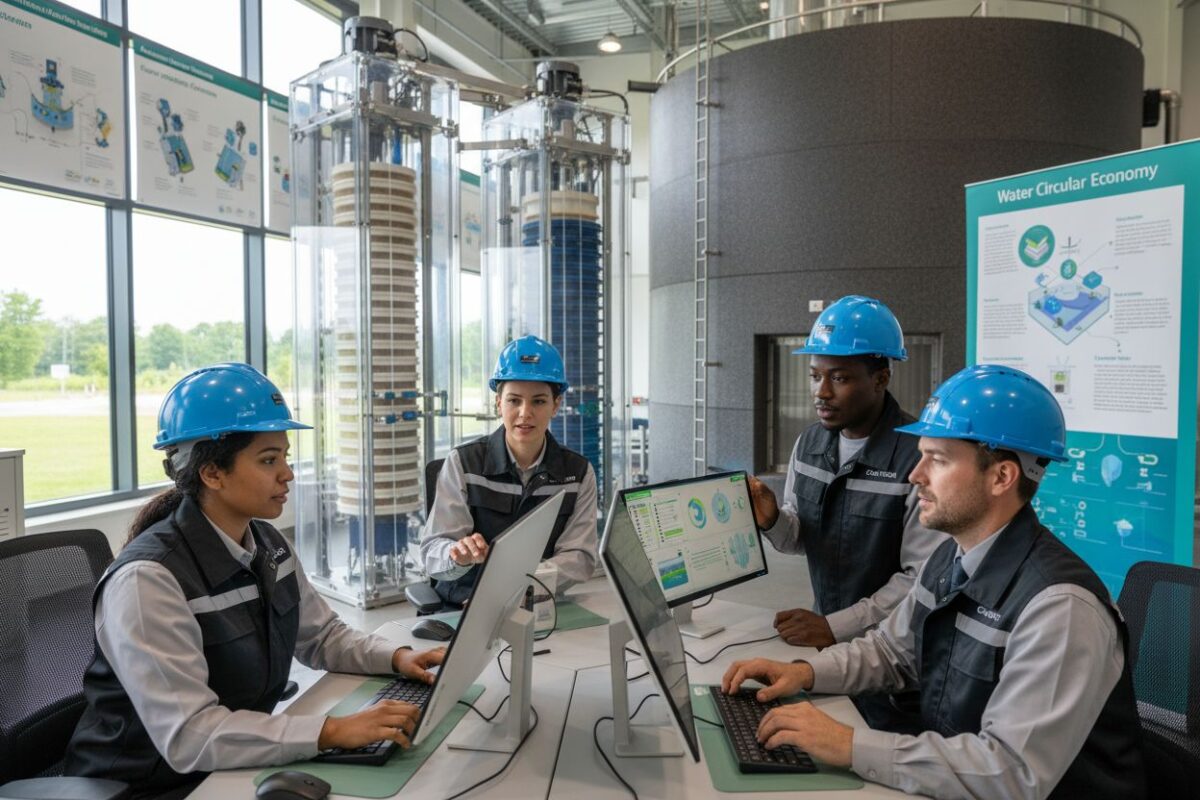Uncategorized
Role of Sustainability in Water Purification: Complete Guide
Did you know that water purification and distribution can account for up to 13 percent of total electricity use? Clean water is essential for both daily life and environmental health, but traditional treatment methods often come with steep energy and ecological costs. As communities face rising challenges like contamination and climate shifts, understanding sustainable water purification becomes more important. Cutting-edge solutions are changing how we protect water quality, manage resources, and secure a safer future for everyone.
Key Takeaways
| Point | Details |
|---|---|
| Sustainability in Water Purification | Emphasizes holistic approaches integrating innovative technologies for environmental protection and water preservation. |
| Emerging Technologies | Membrane filtration and circular economy strategies significantly reduce energy consumption and enhance resource recovery. |
| Economic Considerations | Sustainable water treatment solutions offer long-term financial benefits despite higher initial costs, promoting efficiency and environmental responsibility. |
| Impact of Consumer Choices | Awareness of resource efficiency and pricing strategies can guide consumers toward sustainable water purification methods. |
Table of Contents
- Defining Sustainability In Water Purification
- Key Methods For Sustainable Water Treatment
- Environmental Impact And Resource Conservation
- Cost Implications And Consumer Choices
- Comparing Sustainable And Conventional Purification
Defining Sustainability in Water Purification
Sustainability in water purification represents a holistic approach to addressing water quality and conservation challenges through innovative technologies and strategic resource management. Sustainability goes beyond traditional filtration methods, encompassing environmental protection, energy efficiency, and long-term water resource preservation.
According to the American Chemical Society, sustainability involves integrating advanced treatment technologies that can effectively respond to growing challenges like contamination, drought, and climate change. This approach emphasizes developing supplementary water sources through techniques such as:
- Desalination
- Wastewater reuse
- Rainwater harvesting
Remarkable examples of sustainable water purification emerge from organizations like AguaClara at Cornell University, which designs gravity-powered water treatment systems that require no electricity. These innovative solutions demonstrate how sustainability can create resilient, low-energy municipal water treatment infrastructure. By prioritizing energy-efficient technologies and conservation measures, water purification can simultaneously address environmental concerns and community water needs.
Sustainability in water purification ultimately means creating systems that are not just effective at cleaning water, but also environmentally responsible, economically viable, and adaptable to changing global conditions. Understanding water purification trends can help consumers and professionals make more informed choices about water treatment technologies that support long-term ecological balance.
Key Methods for Sustainable Water Treatment
Sustainable water treatment involves innovative approaches that minimize environmental impact while maximizing water quality and resource efficiency. Membrane filtration, biological processes, and circular economy strategies are emerging as critical techniques for transforming traditional water purification methods.
According to recent research, membrane-based technologies can dramatically reduce energy consumption. Studies show these methods can decrease energy use by approximately 50%, with additional benefits like biogas generation from sludge treatment potentially cutting external energy demand by 15–25%. These approaches also yield significant carbon dioxide emissions reductions of 10–20%.
Decentralized water treatment strategies offer promising sustainability solutions.
 For instance, graywater recycling in residential settings has demonstrated remarkable potential by lowering potable water demand:
For instance, graywater recycling in residential settings has demonstrated remarkable potential by lowering potable water demand:
- Single-family homes: ~27% reduction
- Multifamily homes: ~38% reduction
The sustainable water purification methods guide highlights how circular economy approaches are revolutionizing water treatment. These methods not only purify water but also recover valuable resources like water, energy, and nutrients. Globally, such innovative techniques could potentially reuse approximately 50 billion cubic meters of water annually and generate substantial energy savings exceeding 20 terawatt-hours per year compared to conventional treatment systems.
Environmental Impact and Resource Conservation
Sustainable water treatment plays a pivotal role in protecting ecosystem health and conserving critical environmental resources. Resource conservation goes beyond simply treating water, encompassing a comprehensive approach to reducing ecological strain and promoting long-term environmental sustainability.
According to the American Chemical Society, water purification and distribution currently consume 4–13% of total electricity usage. This significant energy demand underscores the urgent need for developing energy-efficient purification technologies that can minimize environmental impact while meeting growing water needs.
A systematic literature review reveals multiple dimensions of environmental conservation through sustainable water treatment:
- Supplying clean water to reduce pressure on natural sources
- Supporting agricultural sustainability
- Enabling energy recovery from wastewater processes
- Protecting ecosystem biodiversity
By implementing innovative water purification methods, we can transform water treatment from a resource-intensive process to an environmentally regenerative system. These approaches not only clean water but actively contribute to ecological balance, demonstrating how technological innovation can align economic needs with environmental preservation. The goal is creating water treatment solutions that are simultaneously efficient, economical, and ecologically responsible.
Cost Implications and Consumer Choices
Sustainable water treatment represents a strategic investment that balances immediate costs with long-term financial and environmental benefits. Consumer choices in water purification now extend beyond simple price considerations to include comprehensive value assessment that encompasses economic, environmental, and social impacts.
According to the U.S. EPA, water service pricing should reflect the full spectrum of costs, including operations, maintenance, and capital investments. Innovative pricing strategies like tiered and time-of-day pricing can encourage conservation while helping consumers understand the true value of water services. These approaches not only promote sustainable consumption but also provide economic signals about resource efficiency.
Sustainable water treatment solutions offer compelling financial advantages:
- Reduced water purchase and sewer fees
- Lower energy consumption costs
- Potential regulatory compliance benefits
- Enhanced system resilience
- Branding advantages from green credentials
While sustainable water treatment may require higher upfront capital investments, the water purification methods guide demonstrates the significant long-term return on investment. Consumers are increasingly recognizing that choosing sustainable water solutions is not just an environmental statement, but a smart financial decision that delivers value across economic, health, and ecological dimensions.
Comparing Sustainable and Conventional Purification
The landscape of water purification is rapidly evolving, with sustainable methods challenging traditional approaches by offering more environmentally conscious and resource-efficient solutions. Conventional water treatment techniques, while historically effective, are increasingly being scrutinized for their high energy consumption and environmental footprint.
According to research, conventional methods like desalination have substantial limitations. For instance, desalination costs have historically been prohibitively expensive, ranging from US$1.10 per cubic meter in 2000 to approximately $0.50 today. In contrast, sustainable approaches such as membrane filtration and graywater reuse demonstrate remarkable efficiency improvements.
Key differences between sustainable and conventional purification methods include:
Here’s how sustainable and conventional water purification methods compare:
| Criteria | Sustainable Methods | Conventional Methods |
|---|---|---|
| Energy Use | 50% lower | High consumption |
| Emissions | 10–20% less CO₂ | Higher emissions |
| Resource Recovery | Water, energy, nutrients | Rarely recovered |
| Operational Cost | Lower long-term | Higher ongoing |
| Upfront Cost | Higher | Often lower |
- Energy consumption: Sustainable methods reduce energy use by up to 50%
- Emissions reduction: Sustainable techniques can lower carbon emissions by 10–20%
- Resource recovery: Sustainable approaches enable water, energy, and nutrient recycling
- Long-term cost-effectiveness: Lower operational and environmental expenses
The sustainable water purification methods guide highlights how innovative technologies are transforming water treatment. By prioritizing circular economy principles, sustainable purification methods not only clean water more efficiently but also contribute to broader environmental conservation efforts, marking a significant departure from resource-intensive conventional approaches.

Make Sustainable Water Purification Your Everyday Reality
Are you worried about high energy costs, water waste, and the long-term effects of outdated filtration methods? This article highlighted how sustainable water purification not only cuts down on emissions and operational costs but also conserves vital resources and protects your family’s health. If you want to experience these benefits in your home, it’s time to choose a solution that truly supports your sustainability goals. Learn more about practical solutions that align with the Role of Sustainability in Water Purification right on our site.

Take the next step to cleaner, greener water today. Discover our advanced Coway water purifiers at https://cowayswaterpurifier.com, where energy-efficient designs, comprehensive service, and science-backed innovation meet your need for reliable sustainability. Don’t wait—explore our full collection now and bring eco-friendly water purification into your home.
Frequently Asked Questions
What are sustainable methods of water purification?
Sustainable methods of water purification include techniques like membrane filtration, biological processes, and circular economy strategies that minimize environmental impact while maximizing water quality and resource efficiency.
How do sustainable water purification methods reduce energy consumption?
Sustainable methods, such as membrane-based technologies, can cut energy consumption by approximately 50% compared to conventional methods, promoting greater efficiency and reducing the overall carbon footprint.
What are the key benefits of implementing sustainable water treatment?
Key benefits of sustainable water treatment include reduced long-term operational costs, lower energy consumption, resource recovery (such as water, energy, and nutrients), enhanced system resilience, and improved environmental conservation.
How does graywater recycling enhance water sustainability?
Graywater recycling in residential settings can significantly decrease potable water demand, demonstrating reductions of around 27% in single-family homes and 38% in multifamily homes, thus promoting more sustainable water use.
Recommended
- Understanding Sustainable Water Purification Methods – Coway Water Purifier
- Understanding Water Purification Trends in 2025 – Coway Water Purifier
- Understanding Water Purification Terms Explained Clearly – Coway Water Purifier
- 7 Top Water Filtration Methods You Need to Know – Coway Water Purifier

